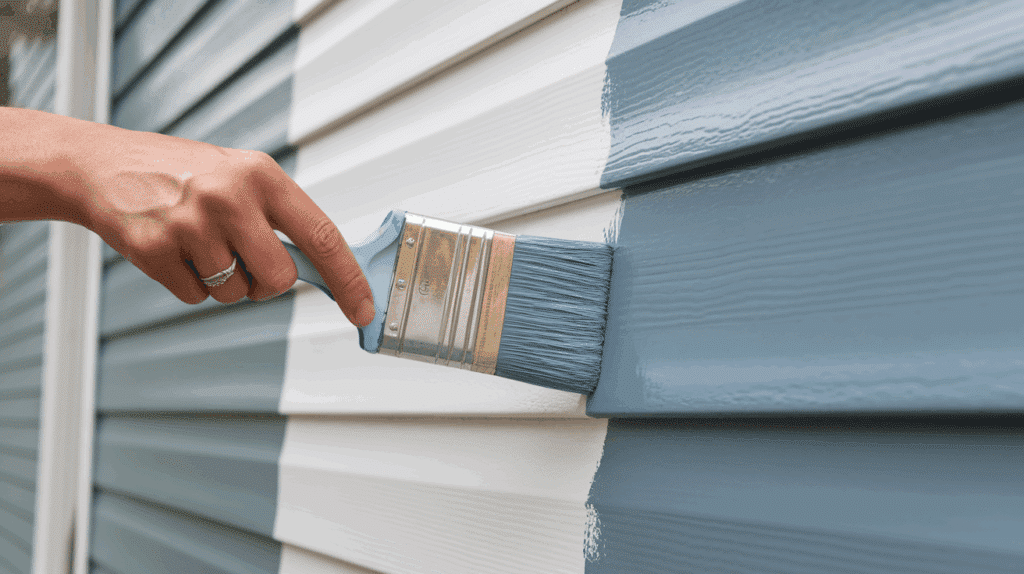If you’ve ever looked at your home and wished the siding had a fresh new look, you might ask yourself, can you paint vinyl siding without causing damage.
I’ve asked the same question, and the good news is that many homeowners are surprised by how simple the answer can be.
In this guide, I’ll walk you through everything you need to know, from choosing the right paint to making the finish last. By the end, you’ll know exactly whether painting is the right move for your home.
What is Vinyl Siding and Can You Paint It?
Vinyl siding is a lightweight, plastic-based material made from PVC.
It’s affordable, low-maintenance, and available in many colors and styles, which makes it a popular choice for homeowners.
Vinyl reacts to heat and sunlight, expanding in warm weather and shrinking when it cools. This movement affects how well paint sticks, so using the right products is important.
Yes, you can paint vinyl siding. It’s safe if the siding is in good condition and you use vinyl-safe paint.
Avoid painting siding that’s cracked or warped, and check your warranty. With proper prep, painted vinyl siding can last for years.
Pros and Cons of Painting Vinyl Siding
Painting vinyl siding has clear upsides and downsides. It’s important to understand both so you can decide whether painting is the right choice for your home.
| Benefits | Drawbacks |
|---|---|
| Cheaper than replacing | Risk of warping with dark colors |
| Improves curb appeal | Needs repainting every 10–12 years |
| Can extend siding life | May void the siding warranty |
| Gives more color options | Won’t fix damaged or brittle siding |
Painting vinyl siding can work well when the siding is in good shape, and you choose the right products.
How to Prep and Paint Vinyl Siding

Prepping vinyl siding is the most important step because it helps the paint stick and last longer. Clean the siding, fix small damage, remove chalking, and choose the right weather (50–85°F with no direct sun) before you begin painting.
Tools and Materials Required
- Vinyl-safe exterior paint
- Paint sprayer, roller, or brush
- Ladder or extension ladder
- Masking tape and drop cloths
- Mild cleaner or vinegar mix
- Cleaning brush or low-pressure washer
Painting Steps
- Mask windows, doors, and outdoor fixtures: Cover anything you don’t want painted so the edges stay clean and protected.
- Test a small panel to check color and coverage: This helps you confirm how the paint looks on your siding before doing the whole house.
- Apply the first coat lightly and evenly: Use smooth, steady passes so the paint sticks well without streaks or drips.
- Let it dry completely as the paint label recommends: Full drying time helps the paint bond to the vinyl and prevents peeling.
- Apply the second coat for full, even coverage: The second layer evens out the color and gives the siding a long-lasting finish.
Types of Paint That Work on Vinyl Siding
Vinyl siding needs the right type of paint to handle heat, movement, and outdoor conditions.
1. Acrylic Paint
Acrylic paint is the most recommended option for vinyl siding because it’s flexible and durable. It expands and contracts with the siding, which helps prevent cracking.
It also provides strong UV resistance, so colors stay bright longer. Acrylic paint is easy to apply and works well in most climates.
2. Vinyl-Safe Exterior Paint
Vinyl-safe paint is specially formulated to prevent warping or heat absorption issues. These paints include safe colorants that keep the siding from overheating.
They also bond tightly to vinyl, reducing peeling or blistering. Homeowners often choose vinyl-safe formulas when using darker colors.
3. Latex Urethane Paint
Latex urethane paint offers the flexibility of latex with the durability of urethane. It sticks very well to smooth surfaces like vinyl. This type of paint also resists chipping and fading over time.
It’s a great choice for long-lasting results in harsh weather.
4. Exterior Latex Paint
High-quality exterior latex paint can also work, as long as it’s labeled for vinyl siding. It’s breathable, which helps moisture escape instead of getting trapped.
Exterior latex is easy to maintain and comes in many color options. It’s best used on siding in good condition.
Painting vs. Replacing Vinyl Siding
Choosing between painting and replacing vinyl siding depends on your budget, the condition of your siding, and how long you want the results to last.
| Category | DIY Painting | Professional Painting | Full Siding Replacement |
|---|---|---|---|
| Cost | Lowest cost (paint + tool rentals) | Higher cost (labor + materials) | Most expensive option |
| Time Required | Slower, done over several days | Fast, usually 1–3 days | Several days to weeks |
| Skill Needed | Moderate to high | No homeowner skills needed | Installed by professionals |
| Finish Quality | Depends on prep and technique | Smooth, consistent, long-lasting | Factory-finished, highest durability |
| Lifespan | About 10–12 years | About 10–12 years | 20–40 years, depending on the material |
| When It’s Best | Budget projects, small homes | Larger homes or when quality matters | Old, damaged, or warped siding |
| Color Options | Must use vinyl-safe colors | Must use vinyl-safe colors | Any color or style available |
| Warranty Impact | May void existing siding warranty | May void existing siding warranty | Comes with a new manufacturer’s warranty |
This table gives a clear side-by-side look at both options so you can choose the one that fits your needs best.
How Long Does Painted Vinyl Siding Last?

Painted vinyl siding stays durable for many years when it’s cleaned, prepped, and painted correctly. Most homes can expect the finish to last 10–12 years before fading begins.
Hot, sunny climates may shorten the lifespan because strong UV rays break down the color faster, while cooler or shaded areas often help the paint last longer.
Repainting becomes necessary when you notice fading, chalking, or uneven color, and homes in harsh weather areas may need touch-ups sooner.
Regular checks for wear will help you know when it’s time for a fresh coat.
Maintenance Tips for Painted Vinyl Siding
Regular care helps painted vinyl siding stay clean, bright, and long-lasting. Here are simple maintenance steps that make a big difference:
- Wash the siding gently once or twice a year: Use mild soap and water to remove dirt so the paint stays fresh and smooth.
- Remove algae or mildew with a mild cleaner: This stops green or black stains from spreading across the surface.
- Rinse off dirt and dust after storms: A quick rinse helps prevent buildup that can dull the finish over time.
- Check for fading or chips during seasonal changes: Look over the siding in spring and fall to catch small issues early.
- Touch up small problem areas before they spread: Fixing minor chips or dull spots right away helps maintain an even color.
These simple habits keep your painted vinyl siding looking clean and help the finish last for many years.
Conclusion
Painting your home’s exterior can feel like a big project, but understanding whether you can paint vinyl siding makes the decision much easier.
With the right paint, good prep, and a careful approach, you can give your siding a fresh look that lasts for years. It’s a budget-friendly way to update your home without taking on a major renovation.
Whether you choose to DIY or hire a pro, the key is making choices that protect your siding and keep the finish looking smooth.
If you’re ready to move forward, start by checking your siding condition and picking a vinyl-safe paint. Begin your project with confidence today.








